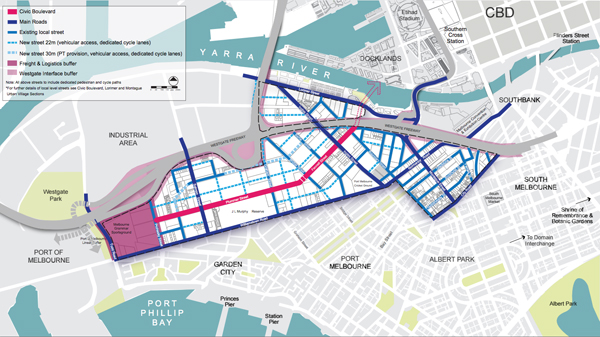
The folly of Fishermans Bend
Share
Image above via Sydney Morning Herald. Article by ADR contributor, Bryan Chung.
The Victorian State Government has approved three apartment developments worth $570 million at Fishermans Bend, which at 1.5 times the size of Melbourne’s CBD, is the largest urban renewal site in the country.
The developments, designed by Rothelowman and CHT Architects, will create 1958 new apartment units. This is part of the government’s plan to establish five new neighbourhoods within the Fishermans Bend area.
The largest of the three developments is on Johnson Street, in the South Melbourne Sandridge precint. Designed by Rothelowman, the development includes 1276 apartments built across four towers, ranging between 21 and 46 levels high. Another Rothelowman designed project is on Normanby Road in the Montague precinct, providing 525 apartments across two towers, 39 and 49 storeys each.
The smallest of the three developments is on Salmon Street, the first building to be approved in the Port Melbourne Wirraway precinct. Designed by CHT Architects, the $40 million apartment block will include 157 apartments built across 12 levels.
Land owners and developers are praising the government’s decision to create higher-density living close to the CBD, claiming that the new apartments will take pressure off established suburbs and help curb Melbourne’s urban sprawl. But others have expressed their skepticism to the scale of rezoning the old industrial precinct in one hit, especially without appropriate public infrastructure like public transport and community facilities.
RMIT planning professor Michael Buxton said it was “scandalous what they did in rezoning such a large area of land as capital city zone without any rules being in place”. There are no mandatory height limits or minimum dwelling sizes, for example. The government has no binding master plan in place, urban design strategy, or money for new roads, public transport, schools, parks or shops. Nor has the government introduced any mechanism to capture a share of the rise in property values for the public purse.
The new developments are in sharp contrast to the earlier plans for Fishermans Bend, proposed by Places Victoria. Fishermans Bend was to have mandatory height limits, the goal of carbon neutrality, and precinct-wide planning. The proposal also envisioned human-scale housing, units made more affordable to low-income households, and developer contributions for social housing.
But in the government’s Fishermans Bend strategic planning framework released in mid-2014, it was clear that these earlier visions had been sidelined. As University of Melbourne fellow in urban geography Kate Shaw warns, developers are unlikely to volunteer the affordable housing or mixed-land uses without government intervention, and such things are almost impossible to deliver in retrospect. According to her, developers will only be after the tallest and most upmarket apartment blocks.

















